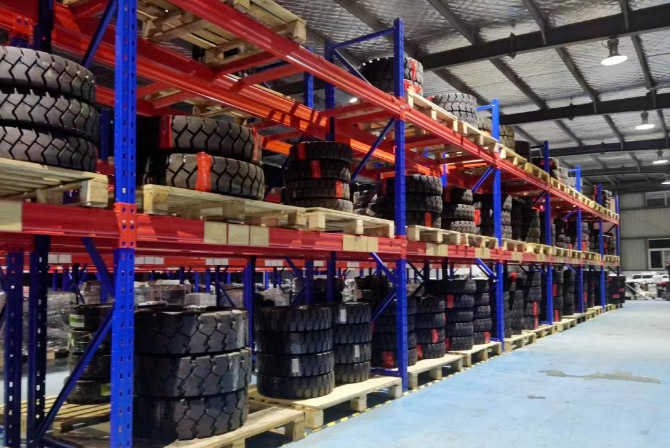Al comprar carretillas elevadoras de combustión interna o carretillas elevadoras eléctricas, muchos clientes consideraránsi equipar la carretilla elevadora con neumáticos sólidos o neumáticosEl editor cree que es mejor instalarneumáticos sólidosEn montacargas. Los neumáticos sólidos ofrecen un excelente rendimiento de seguridad y contribuyen a mejorar la eficiencia del trabajo.
Debido a que la carcasa de los neumáticos sólidos para carretillas elevadoras de combustión interna y carretillas elevadoras eléctricas está hecha completamente de caucho, la resistencia a la perforación del neumático está garantizada al máximo, eliminando fundamentalmente el peligro oculto de perforación del neumático.Durante la operación de carga de la carretilla elevadora y en entornos de trabajo hostilesLos neumáticos sólidos para carretillas elevadoras de combustión interna y eléctricas presentan baja deformación por carga y buena estabilidad operativa. Gracias a su resistencia a pinchazos y desgarros, no requieren inflado, lo que evita la ardua tarea de reparaciones y cambios frecuentes de neumáticos. Esto mejora la tasa de utilización y la eficiencia de trabajo de las carretillas elevadoras de combustión interna y eléctricas. En vehículos de baja velocidad y alta eficiencia, los neumáticos sólidos para carretillas elevadoras de combustión interna pueden reemplazar completamente los neumáticos neumáticos.

Entonces, ¿cuáles son las diferencias específicas entre los neumáticos de carretillas elevadoras de combustión interna y los neumáticos de carretillas elevadoras eléctricas?
Neumáticos para montacargas de combustión interna
Neumáticos para montacargas eléctricos Generalmente se utilizan neumáticos sólidos (indicados por C). La especificación de los neumáticos sólidos se expresa como: diámetro exterior del neumático D * ancho del neumático B (mm). La rueda con neumáticos sólidos está compuesta por radios fundidos, llantas hechas de placas de acero de baja aleación y neumáticos de caucho sólido. Para sujetar el neumático a la llanta, se puede hacer una ranura anular en la superficie exterior de la llanta y la superficie interior del neumático. Para mejorar la adherencia entre el neumático y la superficie de la carretera, se puede hacer una ranura anular en la superficie cóncava del neumático sólido en la superficie del neumático. Para mejorar la adherencia entre el neumático y la superficie de la carretera, se hace un patrón cóncavo en la superficie del neumático sólido. La ventaja de los neumáticos sólidos es su gran capacidad de carga. Cuando se someten a la misma carga, el diámetro de los neumáticos sólidos es menor que el de los neumáticos neumáticos. Los neumáticos sólidos tienen una estructura simple, no necesitan inflarse, son fáciles de mantener y no tienen riesgo de pinchazo. Sin embargo, sus desventajas son que tienen baja elasticidad, poca absorción de vibraciones, se dañan fácilmente en el suelo y el caucho se cae fácilmente.
Cuando las carretillas elevadoras de combustión interna y las carretillas elevadoras eléctricas circulan a alta velocidad, si el neumático choca con un bache u otro obstáculo, se produce una grave deformación por extrusión entre el obstáculo y la pestaña de la llanta, lo que puede provocar la rotura del cable de la carcasa. El aire comprimido del interior del neumático sale del cable roto y forma una protuberancia. En casos más graves, el neumático se rompe por el impacto, desinflándose completamente al instante y pudiendo perder el control del vehículo. En comparación con los neumáticos neumáticos,Los neumáticos sólidos ofrecen alta seguridad, resistencia a la perforación, al desgarro y al desgaste, y una larga vida útil. Son el sustituto ideal de los neumáticos en el sector de las carretillas elevadoras.

Al elegir neumáticos para montacargas, debe considerar los siguientes factores:
1. Entorno de trabajoElija el tipo de neumático adecuado según el entorno en el que opera la carretilla elevadora. Los neumáticos sólidos son adecuados para entornos hostiles, mientras que los neumáticos neumáticos son adecuados para interiores lisos o exteriores con poca nieve.
2. Requisitos de carga:Tenga en cuenta la carga máxima de la carretilla elevadora y elija neumáticos que puedan soportar la carga correspondiente.
3. Marca y calidad:Elija productos de marcas reconocidas, preste atención a las opiniones de los usuarios y al servicio posventa, y asegúrese de la calidad y el rendimiento de los neumáticos.
4. Especificaciones de tamaño:Confirme que el tamaño de los neumáticos sea adecuado para la carretilla elevadora para evitar comprar productos inadecuados.
5. Comparación de precios:Bajo la premisa de cumplir las condiciones anteriores, compare los precios de diferentes proveedores y elija productos con alto desempeño en relación costo-beneficio.
En resumen, la elección de neumáticos para montacargas no solo está relacionada con el funcionamientoeficienciaEl impacto en la calidad de la carretilla elevadora no solo afecta directamente los costos operativos y la seguridad operacional de la empresa. Por lo tanto, al comprar neumáticos para carretillas elevadoras, es necesario considerar exhaustivamente el material, las características de rendimiento y los requisitos de aplicación reales de los neumáticos para tomar decisiones razonables. Al seleccionar cuidadosamente y usar correctamente los neumáticos, se puede mejorar significativamente el rendimiento de la carretilla elevadora, brindando un soporte más estable y confiable a la gestión de logística, transporte y almacenamiento de la empresa. Si necesita accesorios para montacargas, ¡consúltenos!







 español
español español
español English
English français
français русский
русский português
português العربية
العربية











 IPv6 red compatible
IPv6 red compatible